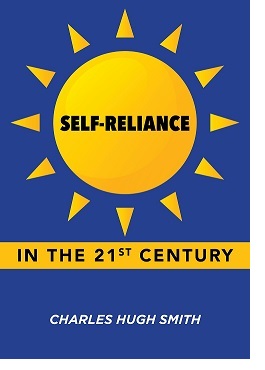
So sorry, but the way of life of low-priced credit and all the goodies it might buy is permanently out of stock.
In focusing on geopolitics, we forget the reliance of every economy on a functioning worldwide economy of inexpensive goods, services, materials, shipping, transportation, capital, labor and financial instruments, all streaming easily across borders and around the globe.
Russia, China, the U.S., and undoubtedly every economy are equally based on access to a working worldwide economy to get essential goods, services and capital and sell surplus production.
The paradox here is the “poor” subsistence villagers with really minimal access to international markets will manage the breakdown of the worldwide economy far much better than the “wealthy” metropolitan residents who are absolutely based on free-flowing global trade. (The villagers will be irritated by spotty cell service; the metropolitan occupants will be hard-pressed to obtain sufficient food and fuel to survive.)
What couple of appear to understand (or acknowledge) is the forces already in motion will overthrow the worldwide economy, and there is no reverse gear. These forces are:
1. De-globalization
2. De-financialization
3. Real-world scarcities that can not be gotten rid of with monetary trickery.
4. Reducing returns on what operated in the past: financial stimulus and other trickery.
5. Asymmetries that can no longer be papered over.
Each of these forces is multi-faceted and complex. Each has the unstoppable momentum of cause and effect. The monetary hoax of the previous thirty years has actually produced a delusional faith that there are no real-world deficiencies or problems that can’t be solved with some brand-new monetary stimulus or gimmick. This is a compelling deception, for all of us want magic that makes the real world do what suits us.
The main misconception is that “money” (credit/currency) from someplace can amazingly draw out as numerous materials and goodies as we want from somewhere else. This is hyper-globalization and hyper-financialization in a nutshell: hyper-financialization is the global commoditization of credit, take advantage of and trickery, enabling the huge expansion of credit, take advantage of and trickery which has actually sustained the remarkable expansion of speculative frenzy which is now the engine of the international economy.
Hyper-globalization is the fulfillment of the neoliberal fantasy that commoditizing self-regulating (ha-ha, you imply cartels and monopolies, fix?) markets would completely decrease expenses and expand credit, intake and success. In this hyper-version of global trade (which has existed for countless years), the mass commoditization of credit and capital streaming freely worldwide, plucking (and exploiting) the most lucrative opportunities anywhere they may be (high-end resort in Timbukthree, count us in, at least until we can find a sucker to purchase our commoditized financial obligation instruments) will all by itself lower expenses and boost production and consumption forever.
Nice, but monetary trickery ultimately encounters real-world restrictions and asymmetries it can not solve. Once the cheap-to-get resources have been depleted, it costs more to extract, process and transport them, even with technological advances.
Other restraints are economic, political and social in nature. Regional populations eventually recognize their resources are being plundered by corporations from afar who arbitrage vast asymmetries in the expense of capital, labor expenses, environmental standards and currency assessments (among others) to stripmine residents and leave them the “dividends” of hyper-globalization and hyper-financialization such as contaminated wastelands and unpayable financial obligations.
Nations eventually awaken to the dangers of becoming depending on others for basics, therefore onshoring, friend-shoring and reshoring all end up being national-defense policies, never mind the corrupting neoliberal dreams of everybody singing Kumbaya around the hyper-globalization and hyper-financialization campfire.
Developing a billion units of currency does not automatically conjure up a billion systems of fresh water, wheat or oil. When there were unexploited reserves of these basics, then massive infusions of capital from elsewhere might fund their extraction, but when the easy-to-get reserves have actually been diminished, then cheap capital does not translate into inexpensive goodies.
The turnaround of these forces has an amusing repercussion which we call inflation. Let’s start by reserving financial dreams such as “inflation is always a monetary phenomenon.” If a main source of oil takes place to be blown to bits and oil jumps $50 a barrel overnight, expenses will rise in a manner that has absolutely nothing to do with the expansion or contraction of the cash supply. “Inflation” is just this: a system of labor/ currency purchases fewer products and services, or buys items and services of lower quality.
However you wish to put it, labor and money lose buying power: each unit of labor/currency buys less than it did in the past.
Inflation has many sources, but let’s focus on the turnaround of hyper-globalization and hyper-financialization. The reversal of financialization increases the cost of capital (interest rates, cost of reducing increasing threat) and the turnaround of globalization increases the expenses of products and services.
The global realities of deficiency and shortage likewise push costs greater.
Put simply, each of these forces is highly inflationary as a matter of domino effect. There is no way to conjure a hat-trick of financial tricks to reverse these forces of greater expenses, i.e. inflation: every unit of labor and currency buys less than it performed in the past.
Authorities have been trained by the golden years of abundance and low expenses to do more of what worked in the past, i.e. financial stimulus of one kind or another. Simply flood the land with credit and currency, and the magic will fix whatever is broken or hobbling.
But the returns on these artifices have reduced to the point that the tricks are not just failing, they are actively making the issues even worse. Thanks to the globalization of “The Fed Put,” moral risk is now the context of every international financial choice. Financial stimulus pumps up speculative bubbles, which inevitably pop, producing waves of distress which additional waves of financial stimulus only accelerate.
The concept that speculative bubbles can painlessly sustain abundance and success is bankrupt, and the collapse of this enticing delusion will collapse the entire global structure of hyper-financialization.
In a tasty irony, stimulus in any form is now inflationary. Doing more of what worked in the previous will now accelerate the “issue” central banks and federal governments are trying to solve: inflation. This truth drives a stake through the heart of all the hopes that doing more of what operated in the previous will amazingly work, even as it adds fuel to the bonfire of higher costs.
Lastly, there is a broad spectrum of destabilizing asymmetries which can no longer be papered over with gimmicks. These include (however are not limited to) profound asymmetries in risk premiums, liquidity and evaluations, resource reserves, political stability, dependencies on worldwide markets for buyers of last resort and so on.
The bottom line is there are few if any countries that could survive undamaged need to hyper-globalization and hyper-financialization collapse and scarcities increase. As I explained in Weaponizing Worldwide Depression, real-world resources and financial, poltical and social systems that are transparent and adaptable are the essential foundations for the shift from reliance to self-reliance.
So sorry, but the lifestyle of affordable credit and all the goodies it might buy is permanently out of stock. The banquet of repercussions is being served even if no one has the appetite for what will be required down their throats by constraint, asymmetries and cause-and-effect.

New Podcast: Chaos Ahead As We Get In The New Period Of’ Shortage ‘(53 min)
 My brand-new book is now readily available at a 10% discount rate ($8.95 ebook, $18 print): Self-Reliance in the 21st Century.
My brand-new book is now readily available at a 10% discount rate ($8.95 ebook, $18 print): Self-Reliance in the 21st Century.
Check out the very first chapter totally free (PDF)
Read excerpts of all 3 chapters
Podcast with Richard Bonugli: Self Dependence in the 21st Century (43 min)
My current books:
The Asian Heroine Who Seduced Me (Unique) print $10.95, Kindle $6.95 Check out an excerpt totally free (PDF)
When You Can’t Go On: Burnout, Reckoning and Renewal $18 print, $8.95 Kindle ebook; audiobook Read the first area for free (PDF)
Worldwide Crisis, National Renewal: A (Revolutionary) Grand Strategy for the United States (Kindle $9.95, print $24, audiobook) Check Out Chapter One totally free (PDF).
A Hacker’s Teleology: Sharing the Wealth of Our Shrinking Planet (Kindle $8.95, print $20, audiobook $17.46) Check out the first section totally free (PDF).
Will You Be Richer or Poorer?: Profit, Power, and AI in a Distressed World
(Kindle $5, print $10, audiobook) Check out the first area for free (PDF).
The Experiences of the Consulting Thinker: The Disappearance of Drake (Unique) $4.95 Kindle, $10.95 print); read the first chapters free of charge (PDF)
Cash and Work Unchained $6.95 Kindle, $15 print) Check out the first area for free
Become a $1/month patron of my work via patreon.com.
KEEP IN MIND: Contributions/subscriptions are acknowledged in the order received. Your name and e-mail remain private and will not be offered to any other specific, business or company.
|
Thank you, Neil C. ($108), for your insanely generous contribution to this site– I am considerably honored by your support and readership. |
Thank you |
, Simon K.W. ($80 HK), for your marvelously generous contribution to this website– I am significantly honored by your steadfast assistance and readership. |

